Anti-Allergic and Anti-Inflammatory Effects of Undecane on Mast Cells and Keratinocytes
Abstract
1. Introduction
2. Results
2.1. Undecane Has no Effect on Cell Viability in RBL-2H3 Cells and HaCaT Cells
2.2. Undecane Suppresses Degranulation of Sensitized RBL-2H3 Cells
2.3. Undecane Regulates cAMP-Mediated Inflammatory Signaling Pathway in HaCaT Cells
2.4. Undecane Reduces the mRNA Expression of Inflammatory Cytokines in HaCaT Cells
3. Discussion
4. Materials and Methods
4.1. Cell Culture
4.2. Cell Viability Assay
4.3. Toluidine Blue Staining
4.4. cAMP Assay
4.5. Histamine and TNF-α Release Assays
4.6. NF-κB p65 Transcriptional Activity
4.7. Western Blotting
4.8. Reverse Transcription and Quantitative Real-Time Polymerase Chain Reaction
Author Contributions
Funding
Conflicts of Interest
References
- Platts-Mills, T.A. The role of immunoglobulin E in allergy and asthma. Am. J. Respir. Crit. Care Med. 2001, 164, S1–S5. [Google Scholar] [CrossRef] [PubMed]
- Kitamura, Y.; Ito, A. Mast cell-committed progenitors. Proc. Natl. Acad. Sci. USA 2005, 102, 11129–11130. [Google Scholar] [CrossRef] [PubMed]
- Robbie-Ryan, M.; Tanzola, M.B.; Secor, V.H.; Brown, M.A. Cutting edge: Both activating and inhibitory Fc receptors expressed on mast cells regulate experimental allergic encephalomyelitis disease severity. J. Immunol. 2003, 170, 1630–1634. [Google Scholar] [CrossRef] [PubMed]
- Sylvestre, D.L.; Ravetch, J.V. A dominant role for mast cell Fc receptors in the Arthus reaction. Immunity 1996, 5, 387–390. [Google Scholar] [CrossRef]
- Galli, S.J.; Grimbaldeston, M.; Tsai, M. Immunomodulatory mast cells: Negative, as well as positive, regulators of immunity. Nat. Rev. Immunol. 2008, 8, 478. [Google Scholar] [CrossRef]
- Asahina, R.; Maeda, S. A review of the roles of keratinocyte-derived cytokines and chemokines in the pathogenesis of atopic dermatitis in humans and dogs. Vet. Dermatol. 2017, 8, 15–25. [Google Scholar]
- Robinson, G.; Butcher, R.W.; Sutherland, E.W. Cyclic AMP. Annu. Rev. Biochem. 1968, 37, 149–174. [Google Scholar] [CrossRef]
- Raker, V.K.; Becker, C.; Steinbrink, K. The cAMP pathway as therapeutic target in autoimmune and inflammatory diseases. Front. Immunol. 2016, 7, 123. [Google Scholar] [CrossRef]
- Serra-Pages, M.; Olivera, A.; Torres, R.; Picado, C.; de Mora, F.; Rivera, J. E-prostanoid 2 receptors dampen mast cell degranulation via cAMP/PKA-mediated suppression of IgE-dependent signaling. J. Leukoc. Biol. 2012, 92, 1155–1165. [Google Scholar] [CrossRef]
- Weston, M.C.; Peachell, P.T. Regulation of human mast cell and basophil function by cAMP. Gen. Pharmacol. Vasc. S. 1998, 31, 715–719. [Google Scholar] [CrossRef]
- Berridge, M. Regulation of cell secretion: The integrated action of cyclic AMP and calcium. In Cyclic Nucleotides; Springer: New York, NY, USA, 1982; pp. 227–270. [Google Scholar]
- Schafer, P. Apremilast mechanism of action and application to psoriasis and psoriatic arthritis. Biochem. Pharmacol. 2012, 83, 1583–1590. [Google Scholar] [CrossRef] [PubMed]
- Kanda, N.; Mitsui, H.; Watanabe, S. Prostaglandin E2 suppresses CCL27 production through EP2 and EP3 receptors in human keratinocytes. J. Allergy Clin. Immunol. 2004, 114, 1403–1409. [Google Scholar] [CrossRef] [PubMed]
- Qi, X.-F.; Kim, D.-H.; Yoon, Y.-S.; Li, J.-H.; Song, S.-B.; Jin, D.; Huang, X.-Z.; Teng, Y.-C.; Lee, K.-J. The adenylyl cyclase-cAMP system suppresses TARC/CCL17 and MDC/CCL22 production through p38 MAPK and NF-κB in HaCaT keratinocytes. Mol. Immunol. 2009, 46, 1925–1934. [Google Scholar] [CrossRef] [PubMed]
- Furue, M.; Terao, H.; Rikihisa, W.; Urabe, K.; Kinukawa, N.; Nose, Y.; Koga, T. Clinical dose and adverse effects of topical steroids in daily management of atopic dermatitis. Br. J. Dermatol. 2003, 148, 128–133. [Google Scholar] [CrossRef]
- Kawakami, T.; Soma, Y.; Morita, E.; Koro, O.; Yamamoto, S.; Nakamura, K.; Tamaki, K.; Yajima, K.; Imaizumi, A.; Matsunaga, R. Safe and effective treatment of refractory facial lesions in atopic dermatitis using topical tacrolimus following corticosteroid discontinuation. Dermatology 2001, 203, 32–37. [Google Scholar] [CrossRef]
- Sakuma, S.; Higashi, Y.; Sato, N.; Sasakawa, T.; Sengoku, T.; Ohkubo, Y.; Amaya, T.; Goto, T. Tacrolimus suppressed the production of cytokines involved in atopic dermatitis by direct stimulation of human PBMC system.(Comparison with steroids). Int. Immunopharmacol. 2001, 1, 1219–1226. [Google Scholar] [CrossRef]
- Schäfer-Korting, M.; Schmid, M.-H.; Korting, H.C. Topical glucocorticoids with improved risk-benefit ratio. Drug Saf. 1996, 14, 375–385. [Google Scholar] [CrossRef]
- TAARIT, M.B.; Msaada, K.; Hosni, K.; Chahed, T.; Marzouk, B. Essential oil composition of Salvia verbenaca L. growing wild in Tunisia. J. Food Biochem. 2010, 34, 142–151. [Google Scholar] [CrossRef]
- White, M.V. The role of histamine in allergic diseases. J. Allergy Clin. Immunol. 1990, 86, 599–605. [Google Scholar] [CrossRef]
- Akdis, C.A.; Blaser, K. Histamine in the immune regulation of allergic inflammation. J. Allergy Clin. Immunol. 2003, 112, 15–22. [Google Scholar] [CrossRef]
- Arrang, J.M.; Drutel, G.; Garbarg, M.; Ruat, M.; Traiffort, E.; Schwartz, J.C. Molecular and functional diversity of histamine receptor subtypes. Ann. N. Y. Acad. Sci. 1995, 757, 314–323. [Google Scholar] [CrossRef] [PubMed]
- Haas, H.L.; Sergeeva, O.A.; Selbach, O. Histamine in the nervous system. Physiol. Rev. 2008, 88, 1183–1241. [Google Scholar] [CrossRef] [PubMed]
- Smit, M.; Hoffmann, M.; Timmerman, H.; Leurs, R. Molecular properties and signalling pathways of the histamine H1 receptor. Clin. Exp. Allergy 1999, 29, 19–28. [Google Scholar] [PubMed]
- Ashida, Y.; Denda, M.; Hirao, T. Histamine H1 and H2 receptor antagonists accelerate skin barrier repair and prevent epidermal hyperplasia induced by barrier disruption in a dry environment. J. Investig. Dermatol. 2001, 116, 261–265. [Google Scholar] [CrossRef] [PubMed]
- Esche, C.; de Benedetto, A.; Beck, L.A. Keratinocytes in atopic dermatitis: Inflammatory signals. Curr. Allergy Asthma Rep. 2004, 4, 276–284. [Google Scholar] [CrossRef]
- Giustizieri, M.L.; Mascia, F.; Frezzolini, A.; De Pità, O.; Chinni, L.M.; Giannetti, A.; Girolomoni, G.; Pastore, S. Keratinocytes from patients with atopic dermatitis and psoriasis show a distinct chemokine production profile in response to T cell–derived cytokines. J. Allergy Clin. Immunol. 2001, 107, 871–877. [Google Scholar] [CrossRef]
- Tüzün, Y.; Antonov, M.; Dolar, N.; Wolf, R. Keratinocyte cytokine and chemokine receptors. Dermatol. Clin. 2007, 25, 467–476. [Google Scholar] [CrossRef]
- Jin, S.-L.C.; Lan, L.; Zoudilova, M.; Conti, M. Specific role of phosphodiesterase 4B in lipopolysaccharide-induced signaling in mouse macrophages. J. Immunol. 2005, 175, 1523–1531. [Google Scholar] [CrossRef]
- Florio, C.; Frausin, F.; Vertua, R.; Gaion, R.M. Amplification of the Cyclic AMP Response to Forskolin in Pheochromocytoma PC12 Cells through Adenosine A2APurinoceptors. J. Pharmacol. Exp. Ther. 1999, 290, 817–824. [Google Scholar]
- Rossi, A.G.; McCutcheon, J.C.; Roy, N.; Chilvers, E.R.; Haslett, C.; Dransfield, I. Regulation of macrophage phagocytosis of apoptotic cells by cAMP. J. Immunol. 1998, 160, 3562–3568. [Google Scholar]
- Torgersen, K.M.; Vang, T.; Abrahamsen, H.; Yaqub, S.; Taskén, K. Molecular mechanisms for protein kinase A-mediated modulation of immune function. Cell. Signal. 2002, 14, 1–9. [Google Scholar] [CrossRef]
- Tasken, K.; Aandahl, E.M. Localized effects of cAMP mediated by distinct routes of protein kinase A. Physiol. Rev. 2004, 84, 137–167. [Google Scholar] [CrossRef] [PubMed]
- Rochais, F.; Vandecasteele, G.; Lefebvre, F.; Lugnier, C.; Lum, H.; Mazet, J.-L.; Cooper, D.M.; Fischmeister, R. Negative feedback exerted by cAMP-dependent protein kinase and cAMP phosphodiesterase on subsarcolemmal cAMP signals in intact cardiac myocytes an in vivo study using adenovirus-mediated expression of cng channels. J. Biol. Chem. 2004, 279, 52095–52105. [Google Scholar] [CrossRef] [PubMed]
- Oki, N.; Takahashi, S.-I.; Hidaka, H.; Conti, M. Short Term Feedback Regulation of cAMP in FRTL-5 Thyroid Cells ROLE OF PDE4D3 PHOSPHODIESTERASE ACTIVATION. J. Biol. Chem. 2000, 275, 10831–10837. [Google Scholar] [CrossRef]
- Itazawa, T.; Adachi, Y.; Okabe, Y.; Hamamichi, M.; Adachi, Y.; Toyoda, M.; Morohashi, M.; Miyawaki, T. Developmental changes in interleukin-12-producing ability by monocytes and their relevance to allergic diseases. Clin. Exp. Allergy 2003, 33, 525–530. [Google Scholar] [CrossRef]
- Novak, N.; Kwiek, B.; Bieber, T. The mode of topical immunomodulators in the immunological network of atopic dermatitis. Clin. Exp. Dermatol. 2005, 30, 160–164. [Google Scholar] [CrossRef]
- Jacobi, A.; Antoni, C.; Manger, B.; Schuler, G.; Hertl, M. Infliximab in the treatment of moderate to severe atopic dermatitis. J. Am. Acad. Dermatol. 2005, 52, 522–526. [Google Scholar] [CrossRef]
- Osinka, K.; Dumycz, K.; Kwiek, B.; Feleszko, W. Novel therapeutic approaches to atopic dermatitis. Arch. Immunol. Ther. Exp. 2018, 66, 171–181. [Google Scholar] [CrossRef]
- Özdemir, Ö. New developments in transplant-acquired allergies. World J. Transplant. 2013, 3, 30. [Google Scholar] [CrossRef]
- Lee, H.; Ha, H.; Lee, J.K.; Park, S.-J.; Jeong, S.-I.; Shin, H.K. The leaves of Broussonetia kazinoki siebold inhibit atopic dermatitis-like response on mite allergen-treated Nc/Nga mice. Biomol. Ther. 2014, 22, 438. [Google Scholar] [CrossRef]
- Dileep, K.; Remya, C.; Tintu, I.; Sadasivan, C. Designing of multi-target-directed ligands against the enzymes associated with neuroinflammation: An in silico approach. Front. Life Sci. 2013, 7, 174–185. [Google Scholar] [CrossRef]
- Mathew, G.; Unnikrishnan, M. Multi-target drugs to address multiple checkpoints in complex inflammatory pathologies: Evolutionary cues for novel “first-in-class” anti-inflammatory drug candidates: A reviewer’s perspective. Inflamm. Res. 2015, 64, 747–752. [Google Scholar] [CrossRef] [PubMed]
- Fiset, P.-O.; Leung, D.Y.; Hamid, Q. Immunopathology of atopic dermatitis. J. Allergy Clin. Immunol. 2006, 118, 287. [Google Scholar] [CrossRef] [PubMed]
- Li, H.; Zuo, J.; Tang, W. Phosphodiesterase-4 inhibitors for the treatment of inflammatory diseases. Front. Pharmacol. 2018, 9, 1048. [Google Scholar] [CrossRef] [PubMed]
- Wagner, B.L.; Bauer, A.; Schütz, G.; Montminy, M. Stimulus-specific interaction between activator-coactivator cognates revealed with a novel complex-specific antiserum. J. Biol. Chem. 2000, 275, 8263–8266. [Google Scholar] [CrossRef] [PubMed]
- Mayr, B.M.; Canettieri, G.; Montminy, M.R. Distinct effects of cAMP and mitogenic signals on CREB-binding protein recruitment impart specificity to target gene activation via CREB. Proc. Natl. Acad. Sci. USA 2001, 98, 10936–10941. [Google Scholar] [CrossRef]
Sample Availability: Samples of the compounds are not available from the authors. |
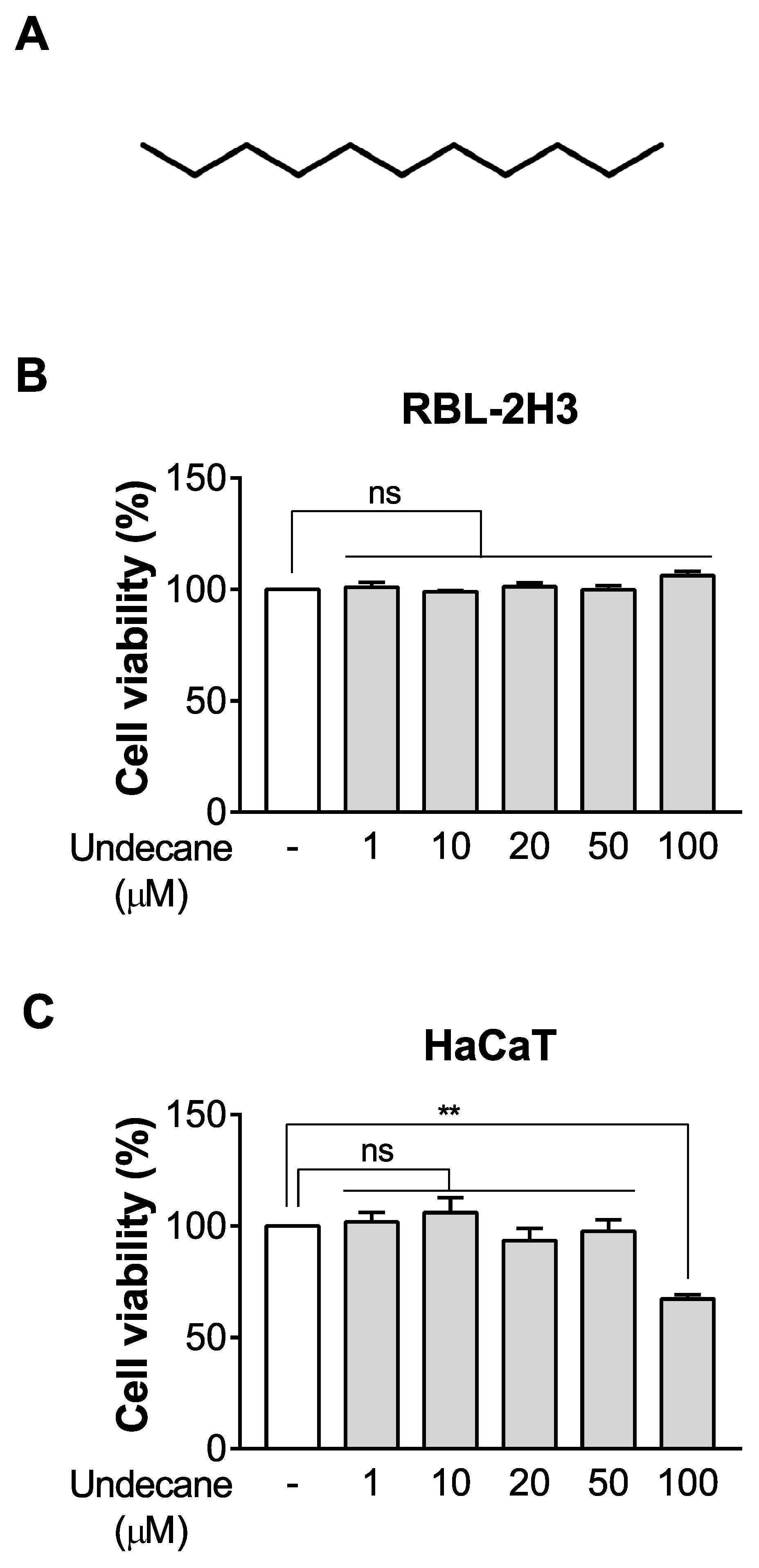
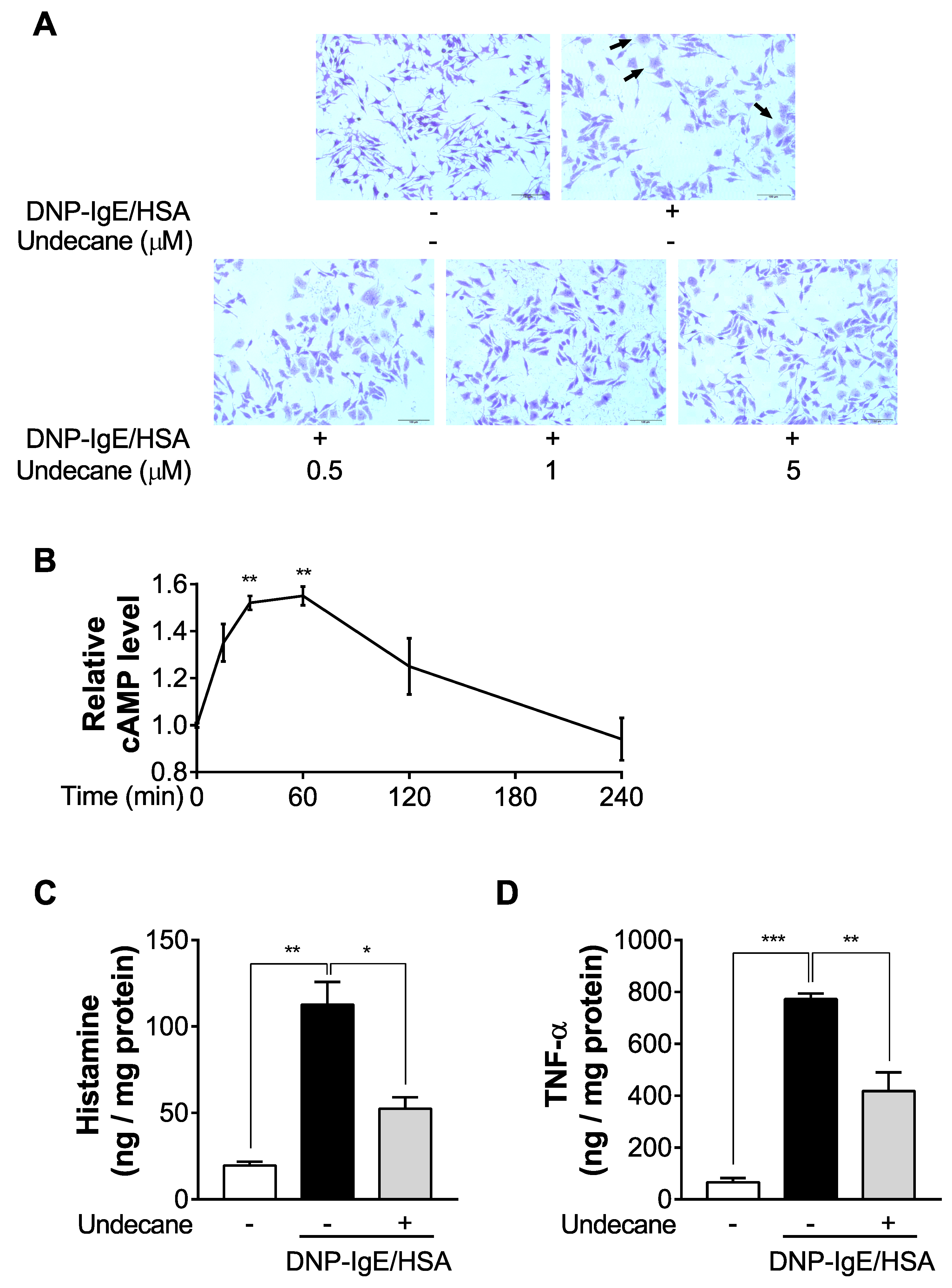
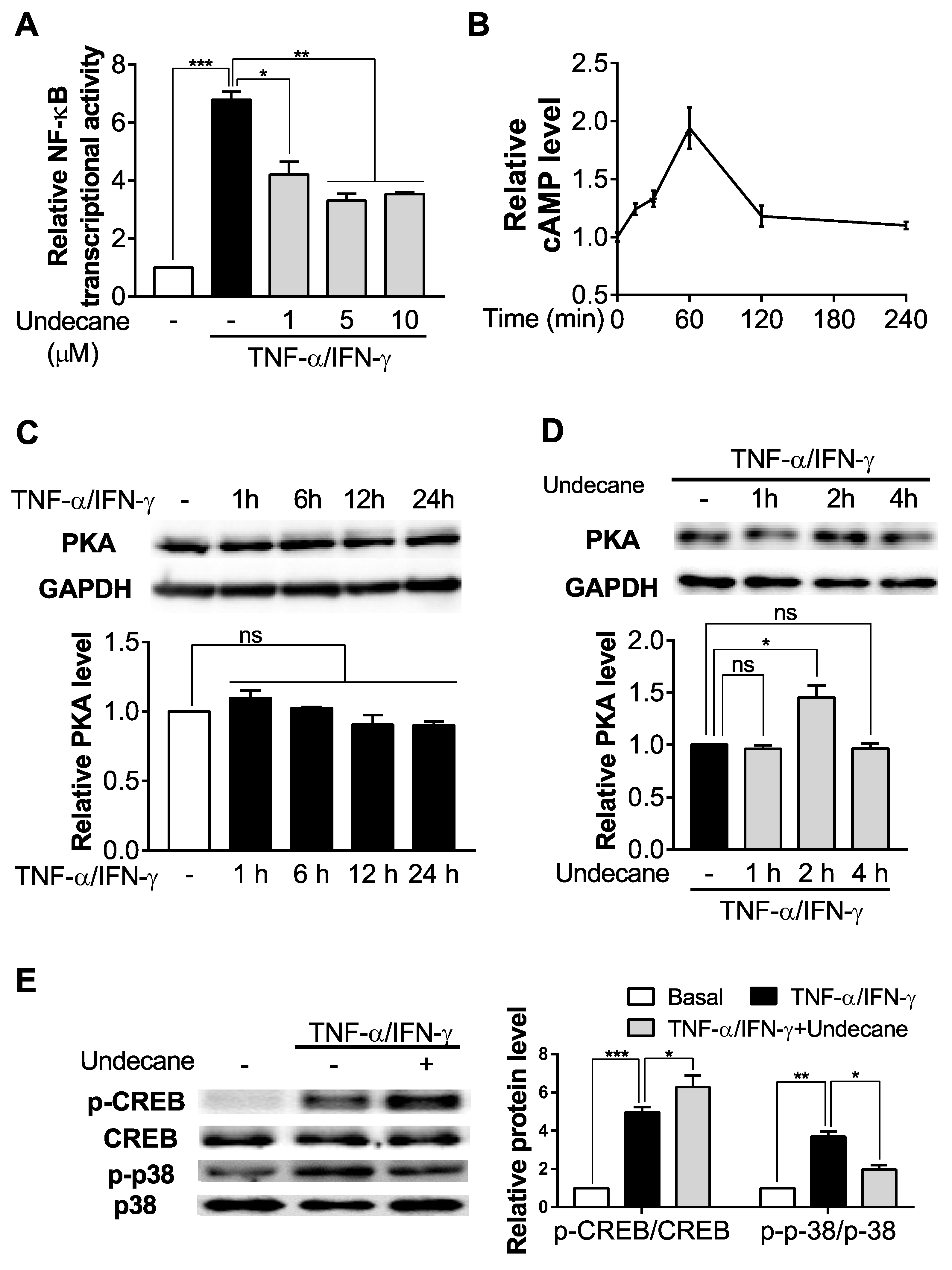
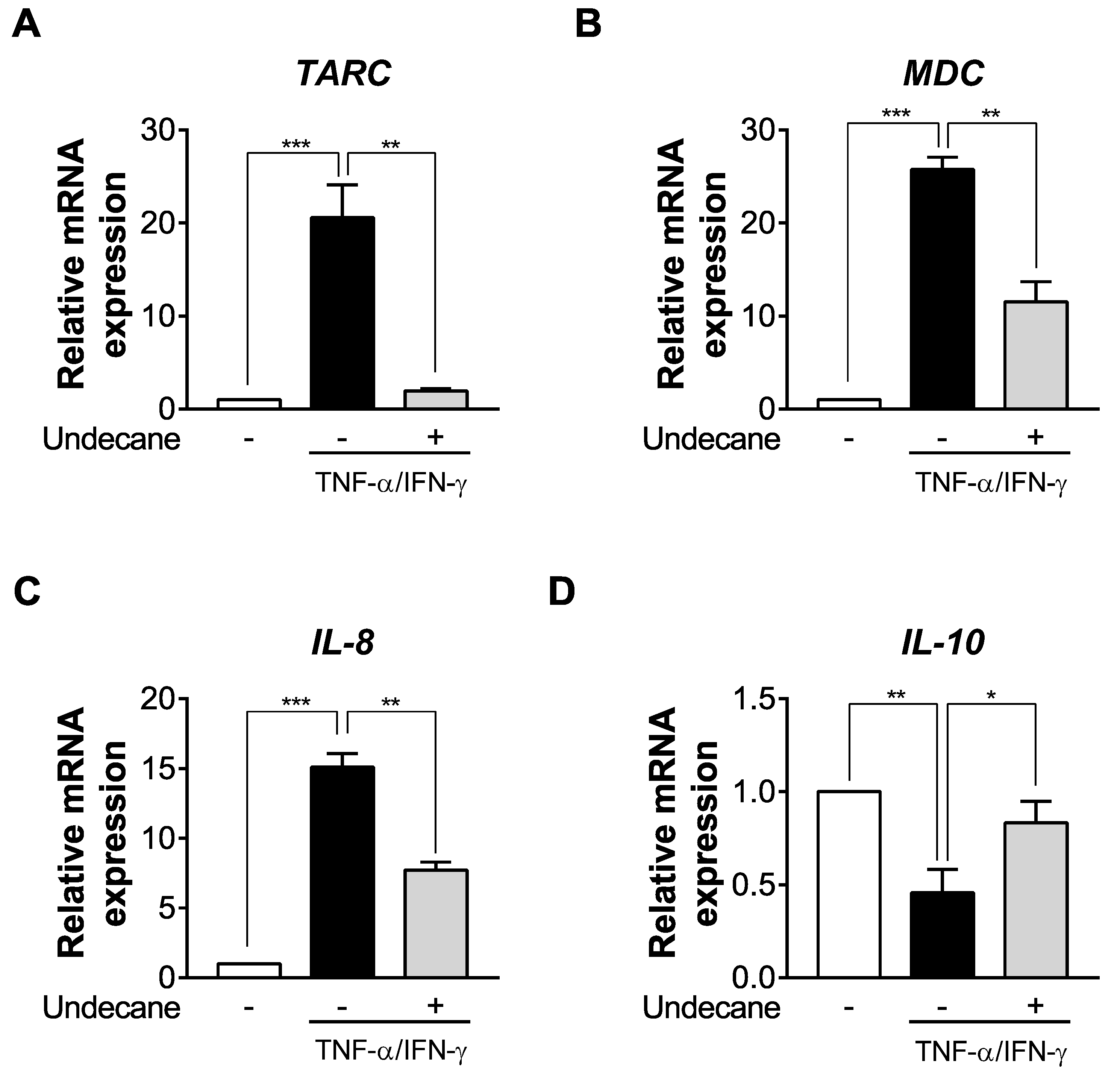
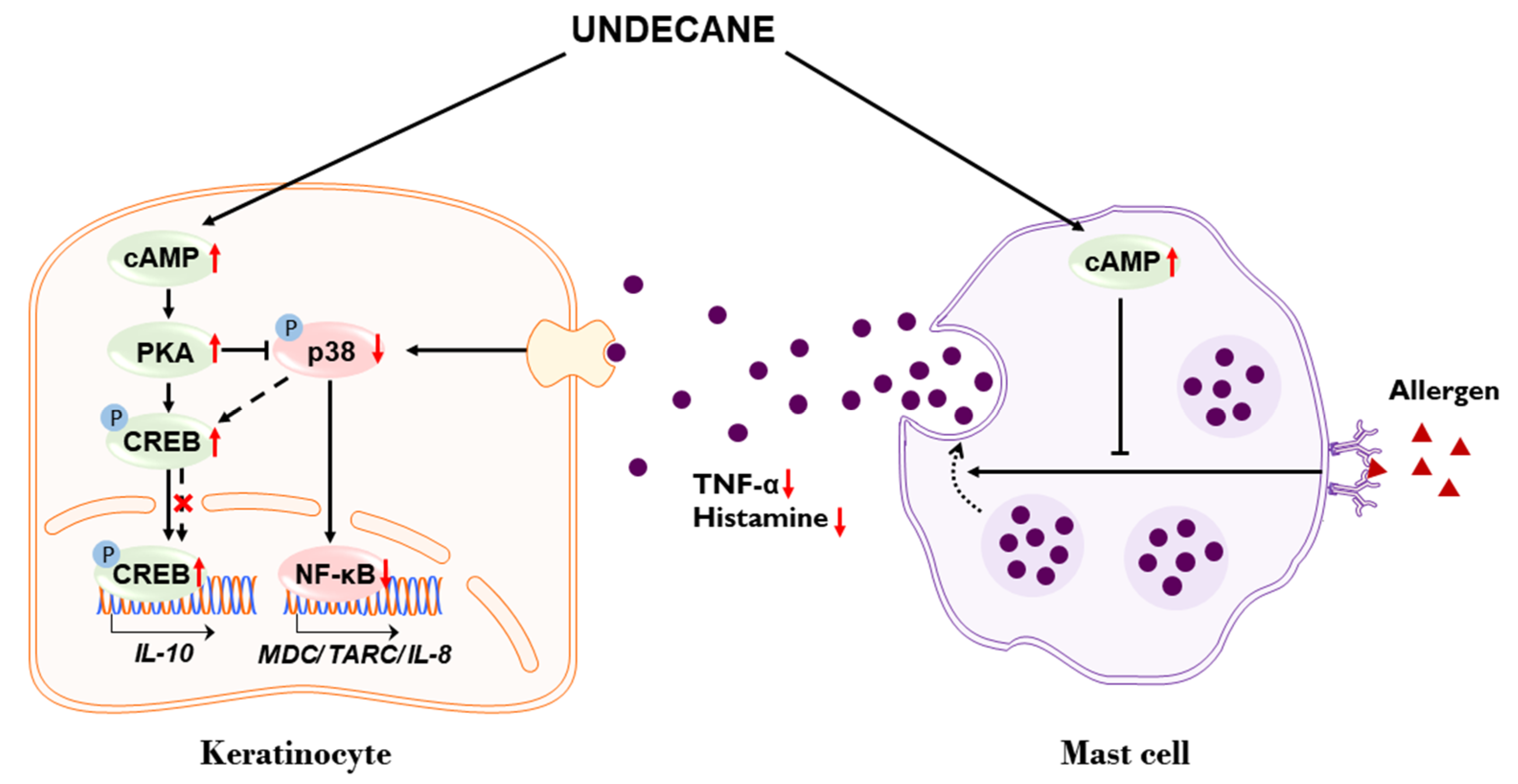
| Gene Description | Sequence (5′→3) |
|---|---|
| Thymus and activation-regulated chemokine (TARC) | F: CCTGGTCACCCTCCTCCTG R: GGTACCACGTCTTCAGCTTTCT |
| Macrophage-derived chemokine (MDC) | F: CCCTACGGCGCCAACAT R: CAGACGGTAACGGACGTAATCA |
| Interleukin-8 (IL-8) | F: TGACTTCCAAGCTGGCCGTG R: TTCTGTGTTGGCGCAGTGTGG |
| IL-10 | F: GATCCAGTTTTACCTGGAGGAG R: CCTGAGGGTCTTCAGGTTCTC |
| Glyceraldehyde-3-phosphate dehydrogenase (GAPDH) | F: GTGATGGCATGGACTGTGGT R: GGAGCCAAAAGGGTCATCAT |
© 2020 by the authors. Licensee MDPI, Basel, Switzerland. This article is an open access article distributed under the terms and conditions of the Creative Commons Attribution (CC BY) license (http://creativecommons.org/licenses/by/4.0/).
Share and Cite
Choi, D.; Kang, W.; Park, T. Anti-Allergic and Anti-Inflammatory Effects of Undecane on Mast Cells and Keratinocytes. Molecules 2020, 25, 1554. https://doi.org/10.3390/molecules25071554
Choi D, Kang W, Park T. Anti-Allergic and Anti-Inflammatory Effects of Undecane on Mast Cells and Keratinocytes. Molecules. 2020; 25(7):1554. https://doi.org/10.3390/molecules25071554
Chicago/Turabian StyleChoi, Dabin, Wesuk Kang, and Taesun Park. 2020. "Anti-Allergic and Anti-Inflammatory Effects of Undecane on Mast Cells and Keratinocytes" Molecules 25, no. 7: 1554. https://doi.org/10.3390/molecules25071554
APA StyleChoi, D., Kang, W., & Park, T. (2020). Anti-Allergic and Anti-Inflammatory Effects of Undecane on Mast Cells and Keratinocytes. Molecules, 25(7), 1554. https://doi.org/10.3390/molecules25071554






